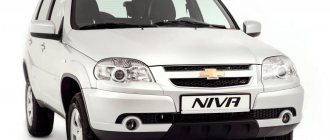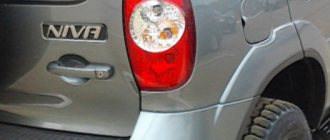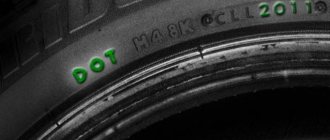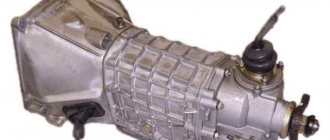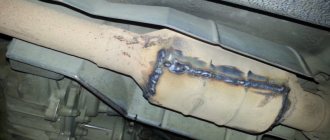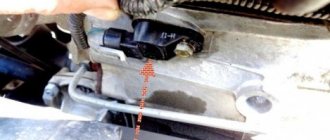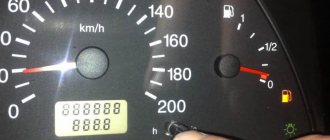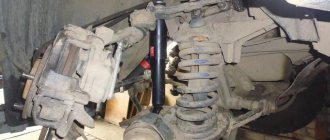The cost of owning a car is made up of many factors, one of the main ones being fuel consumption. Let's figure out what gas consumption for the Lada Niva (Chevrolet) is indicated in the technical specifications. And how different it is from real owner reviews.
Objective difficulties of fuel economy on the Niva-Chevrolet
The officially declared fuel consumption on the highway for the Chevrolet Niva is 8.80 l/100 km. In the summer, the actual consumption is close to the declared one, and with a smooth driving style without pressing the pedal “to the floor” and without sudden starts and braking, it is even a little lower. In winter it rises to 10.0 l/100 km. In the combined cycle, these values are 10.5 liters for “summer” and 13.3 liters for “winter”. In the city the figure reaches 14 liters.
Taking into account the fact that this car is an SUV and is intended for driving on rough terrain, during actual operation the average consumption is quite high.
When “driving off the road,” the driving style becomes suboptimal, and all-wheel drive is almost always engaged, and most often additional cargo is carried. As a rule, such a car is bought with the idea of using it for trips to the country, hunting, fishing or off-road tourist expeditions.
Therefore, experts who tell how to reduce fuel consumption on a Chevrolet Niva divide fuel saving solutions in this model into regulated and low-regulated ones. The second includes the design features of the car, on which fuel consumption depends, but which are difficult to influence.
- Motor design.
Car enthusiasts believe that the engine installed on the Niva-Chevrolet is morally outdated and simply cannot provide noticeable savings during operation even after improvement. General Motors made attempts to refine the engine by lightening the connecting rods and pistons, as well as reworking the cylinder block. Judging by the reviews, this made the car quieter, but not more economical.
Vehicle weight.
The heavier the car, the greater the fuel consumption, all other things being equal. On average, for every 100 additional kilograms of weight, consumption increases by 0.7-1.0 l/100 km. The Chevrolet Niva is a car weighing about 1.5 tons (which is quite a lot for its size) and is also functionally designed for transporting goods.
All-wheel drive and automatic transmission.
The energy-consuming functionality here comes into conflict with the idea of saving. If the main goal is fuel economy, then why buy an all-wheel drive SUV with an automatic transmission? In this case, it is more logical to immediately consider purchasing other models. Therefore, recommendations to “permanently disable all-wheel drive” or “switch” to manual transmission do not always seem correct - after all, the car was bought for ease of driving and reliability in overcoming obstacles.
Common problem
Often the knock sensor on the 2123 engine fails. When installing it, it is “tightened” - the tightening torque should be 18 N*m.
You just need to take it and replace the DD. Suitable options:
- 21120-3855020-00, -01, -02, -03;
- Fenox SD10100O7;
- BOSCH 0 261 231 046.
There will be two problems:
- The DD on the VAZ-2123 is accessible only from under the bottom (remove the lower panels);
- The ECM does not recognize the new sensor immediately, but after 20-30 km of “break-in”. Like this.
Video with a review from one owner about fuel consumption on a Chevrolet Niva
Didn't find the information you are looking for? on our forum.
We recommend reading:
- What kind of gasoline to fill in the Lacetti, 92 or 95
- Chevrolet Cruze gasoline consumption, city, highway, combined cycle
- How to convert a Lacetti to 92 gasoline, which gasoline is better for a car
- The smell of gasoline in the interior of a Chevrolet Niva, the reason
- Chevrolet Aveo, amount of engine oil
- Chevrolet Niva what gasoline 92 or 95, manufacturer's recommendations
- High gasoline consumption in Chevrolet Niva, possible reasons
- How to drain gasoline from a Chevrolet Niva, three ways
Regulating fuel consumption on Niva
When choosing less radical solutions, technical adjustments begin by considering the typical causes of high fuel consumption:
- determining the degree of friction in the braking system,
- front wheel adjustments,
- control over the thickness of the oil in the transmission,
- measuring the air pressure in tires (slightly overinflated tires - by 0.2 atmospheres - give a positive economic effect),
- checking the condition and clearance of spark plugs, high-voltage wires, cleanliness of injectors and filters.
The following savings methods specific to Niva are mentioned:
- Replacing the fan. Experiments by car enthusiasts have shown that the 6-blade Niva fan consumes about 0.7 l/100 km, which is 40% more than the 4-blade fan from the Zhiguli with 0.5 l/100 km.
- Replacing tires. “Niva” with “toothy” VLI-5 tires consumes 5% more of the total fuel consumption than with VLI-10 tires.
- Redirection of the accelerator pump to chamber 1.
- Installing and adjusting the position of the fuel needle in the carburetor needle and Unicar jets.
In a practical way, determining how to reduce fuel consumption on the Niva 21214, car enthusiasts experimented with driving at different speeds (injector, Bosch 7.0). So the consumption at 3000 rpm during acceleration was practically no different from acceleration at lower rpm. At a speed of 70-80 km/h on a flat road without acceleration, consumption was recorded at 8 l/100 km, which turned out to be 1 liter less than at speeds of 2000-2200. However, in this experiment and the subsequent discussion, the weighted average opinion came down to the fact that it is more economical to drive “pull” in any gear.
In assessing the low aerodynamics of this model, all car enthusiasts came to a unanimous opinion and the following conclusions:
- tuned cars (and Nivas are especially often weighted) consume more fuel,
- the upper (even empty) trunk increases consumption by 0.5 l/100 km,
Open car windows also significantly increase resistance, so to ventilate the interior without air conditioning, it is recommended to leave small gaps.
Source: hitropop.com
High fuel consumption: reasons
If the transmission components did not consume energy themselves, an all-wheel drive vehicle would be more economical than a single-wheel drive vehicle. Necessary conditions are non-disconnectable all-wheel drive and the presence of locking differentials. It seems that the Chevrolet Niva has all this.
What will happen in reality? If the front driveshaft is removed from the structure, fuel consumption will be 14.2 liters, and for the “standard version” the figures will be slightly worse - 14.8 liters per 100 km. All these figures were measured under the same conditions.
When it comes to significant weight and low tire pressure, practice really does match theory. For example, the Ural-375 all-terrain vehicle in the 6x6 version turns out to be more economical than with a 6x4 drive.
We can conclude that the energy consumed by the Chevrolet Niva transmission exceeds the losses caused by rolling friction in the tires. This is bad. However, for most light SUVs everything looks exactly the same.
Fuel consumption Niva Chevrolet
Fuel consumption is an important issue for many SUV owners. Its volume depends not only on the cubic capacity of the engine, but also on the design features of the transmission, driving style or operating conditions.
Typically the manufacturer specifies average fuel consumption, but these values apply to “ideal” conditions.
The Chevrolet Niva is no different from its classmates in terms of efficiency, but when used correctly, it consumes fuel in moderate quantities.
In order to be able to compare this indicator and draw the right conclusions, you need to know the standard values and possible causes of excessive fuel consumption.
Normal fuel consumption 2123
The domestic SUV was developed on the basis of the classic Niva 2121, which traveled along the roads of the former USSR. Back then, gasoline was cheap and efficiency was not a primary goal.
Engineers sought to create a passable and maintainable car.
When releasing the modern Chevrolet Niva, significant changes were made to the fuel and air supply system. The car received an electronic control unit. This provided a more “moderate appetite” for the SUV. With a mixed cycle, 10.2 liters of fuel were consumed.
These are minimum values; in practice, the consumption is slightly higher:
- mixed cycle - 12 l;
- on the highway – 9-10 l;
- within the city - up to 13-14 liters.
Experts believe that fuel consumption for the 1.7 engine is slightly too high. This is due to the fact that the car is all-wheel drive: two gearboxes are constantly running on it. To rotate their gears, the power unit makes additional efforts. However, there are more advantages than disadvantages: this gives maximum cross-country ability with a slight overrun of 5-10%.
It has been established that when refueling 92 and 95 gasoline, the consumption is different. With a high octane number, the car's appetites are more moderate. However, according to critics, AI-92 is counterfeited less often.
Consumption in the city
Naturally, most people are interested in how much fuel they will spend driving around the city in a Chevrolet Niva car. Fuel consumption per 100 km in urban conditions is naturally much higher than on the highway, taking into account all the needs to brake, completely stop the car, start again, and so on. Because of this, the consumption rate increases to 14.2 liters per hundred kilometers. In reality, this figure is practically confirmed in summer conditions, where consumption is 13.6 liters per hundred kilometers, but in winter it is slightly higher - 14.5 liters. On average, the real figure is even less than the officially declared one - 14.05 liters per hundred kilometers. These are pretty nice numbers for drivers. But what is the combined fuel consumption of the Chevrolet Niva per 100 km?
How to reduce fuel consumption?
You can reduce fuel consumption to the values set by the manufacturer or 0.5-1 liters below the norm.
This can be achieved in the following ways:
- Choosing the right mode - with smooth acceleration and braking and driving at medium speeds, you will never have excessive fuel consumption. Select a gear depending on the type of road surface.
- Fill only with high-quality gasoline - at trusted gas stations that have confirmed their reputation. Don’t go for the cheap, remember: “the miser pays twice.”
- Carry out diagnostics regularly and timely service your vehicle. This will eliminate breakdowns and prevent problems in the power system. If necessary, visit a diagnostician periodically.
- Change the firmware - on models after restyling, you can remove the catalyst and change the software. This will increase power and reduce “appetite” by 10%.
Some “craftsmen” remove one of the cardans, which provides savings of up to 1.5 liters per 100 km. But during normal operation, the second gearbox wears out faster and will soon require repairs.
Is there an alternative?
To save fuel, some suggest converting to gas. There is a lot of debate on this issue, however, if you agree to such a rework, you should take into account the opinions of critics:
- It is not possible to repair the engine at every service center - for service you will have to visit a specialized workshop;
- gas consumption is higher - compared to gasoline, 1.5 times more fuel is required;
- burnout of the cylinder head gasket - the standard resource of 150 thousand km can be safely divided in half;
- gas takes away power, and Niva already doesn’t have enough of it;
- cross-country ability is reduced - if a gas cylinder is installed behind the rear gearbox, it noticeably reduces ground clearance.
Practice shows that HBO is not the best option for Niva. To increase cross-country ability, some try to place the cylinder in the trunk, but the container will take up its entire volume.
Adding to the complexity is increased engine wear and reduced vehicle performance.
Still, the best option for a Chevrolet Niva is high-quality gasoline and proper care.
Source: nivachevrole.ru
Chevrolet Niva with a 1.8 liter engine
From 2006 to 2008, a limited edition of the Chevrolet Niva was produced - VAZ 21236 (FAM-1). These cars were equipped with the Opel Z18XE engine with a volume of 1.8 liters. This motor is more powerful compared to the VAZ one. With a volume of 1.8 liters, its power is 122 hp. s., and torque – 167 Nm at 3800 rpm. The maximum speed of the Chevrolet Niva with this engine is 165 km/h. Acceleration time from 0 to 100 km/h is 12 seconds.
It will also be interesting to read: Mercedes Benz G class 2018-2019 model year
True, the price of a Chevrolet Niva with a 1.8-liter engine was significantly higher than with a 1.7-liter engine. Therefore, they did not buy the Chevrolet Niva 1.8 so willingly, and 2 years after the start of production they stopped producing them. Those cars that were sold in 2 years now continue to drive around the country.
see also
Comments 33
Press less in your slippers.
This is the problem - I can bench press less, but you can’t explain it to my wife, she benches as much as she wants
Chip as an option, consumption will drop, power will also drop if you are ready to make sacrifices and don’t want to sell the tires. When chippers do one thing, while other riders fall, this is the only option I see, other than switching to a regular city runabout.
a subcompact car is a definite no, they are small and low, but the family is growing and the roads are getting worse
Chip as an option, consumption will drop, power will also drop if you are ready to make sacrifices and don’t want to sell the tires. When chippers do one thing, while other riders fall, this is the only option I see, other than switching to a regular city runabout.
I changed the brain. There was an old factory firmware - Lilo 15 liters. Now the diagnostician promised 9-9.5 liters. the changes are felt - the ride is much better. I’ll also install a front axle disconnect switch on the transfer case, which should further reduce the consumption.
I wouldn’t recommend switching the traction to the rear axle, it’s not provided by the factory. At risk, plus they say it doesn’t slow down that much, the engine is already weak.
buy another car, sell the Shniva.
And what is the expense?
Having bought zhyp, they don’t cry for gasoline)))
That's right, Vova! Fak the fuel save! )))
Buy “Oka” and rejoice, 4 liters per 100
Switch to alternative types of fuel ;-) but in general, even without air flow sensor, consumption in the city is no more than 12 liters, provided everything else is in working order ;-) I don’t have a catalyst as a sensor for it
there is only one solution - Duster diesel
from 7.2 to 10.5 reasons million. 1. mass air flow sensor (MAF) - its condition. main! 2. control lambda probe (the first one immediately behind the manifold). 3. Gasoline is stolen or leaks. Jackie Chan glows? Sports ECM chip? the chain stretched out and moved the camshaft along the mark. gasoline 92 or 95?, tires (model (picture), how inflated, tubeless camera), spark plugs, explosive wires (northern lights?), trailer, handbrake? Is the lowering switch on? Is there anything sticking in the chassis? when the air intake was changed, the compression in the cylinders, the valve burned out, what is the condition of the catalytic converter cells? etc…
Video with a review from one owner about fuel consumption on a Chevrolet Niva
Learn to use engine braking and avoid sudden acceleration and braking. Do not allow more than three thousand revolutions. All this will significantly reduce consumption.
If possible, do not overload the machine. Every extra 10 kg. lead to increased fuel consumption.
Such nonsense, fuel consumption is 11 liters on the highway. In my Lexus LX 570 I get 12.3 on the highway
I have a Tuareg 3 liter, 224 horses, diesel, on the highway 10.7-11.5... the average is usually 12.2-12.5... I had a lot of Nivs from 31st to Chevy! Chevy is a bucket that eats immeasurably and barely drives!
trunk on top, suspension lift, off-road tires, I achieved a consumption of 15 liters
Hmm, my neighbor has a 200 Kruzak, V8, in the winter in the city it’s at least 16 liters, and on the highway it depends on how you drive, it eats up 10 liters, and if you drive, you just have time to refuel.
There was a mug 100 v8city 18-22 highway 13 _18 less only if two Niva Chevik city are sick from progression to 17 highway 11-14 depending on the speed
Don’t rush, and the expense will be small - but you have to wait until you start retiring.
Good time! In March 2020, I had the opportunity to drive 420 km on a service Shniva in 7 days, including the city, the highway, steep climbs, and covered snow ruts. The average consumption was 10.5 liters. Great car! If it were cheaper or the salary was higher, I would definitely buy it!))) I’ll add to what was written earlier, comrade Shniv eats 11 liters in the city, 9 liters on the highway. Good travels to everyone!
I have a 2006 Chevy Niva. The consumption is similar, the main thing is not to drive on the highway for more than 120 km.
My Chevy chip tuning has reduced consumption per liter.
Good afternoon, ladies and gentlemen. I would like to write a little about the Chevrolet Niva. This is my second car, because I love driving off-road, I have owned a Niva for 12 years, I have had 3 Chevrolet Niva cars in total. I want to say one thing, in many comments there is an incorrect comparison between the Niva and foreign cars like Cruiser, Lexus and other SUVs. But let's not forget about the price category of cars. For 600 thousand rubles you will not buy a WHOLE imported SUV, of course you can prove with foam at the mouth that you can take an 80 or 1000 cruiser, but buying is one thing, but few people have thought about the fact that you still need to pour money into such a car less than 500 thousand rubles for her to travel. As for quality, it depends on your luck. But there are several shortcomings that AvtoVAZ does not want to part with, the engine, well, that’s okay, the car is not for speed after all. But the tapered wheel bearings are the first serious drawback, then the lower ball bearings, which are weak, are used as consumables. Likewise, play throughout the entire transmission, a disease of any field, begins with 15-17 thousand mileage. As for the engine, I drove 150 thousand on each car, never had any problems with the engine, only changed the idle speed sensor. Therefore, those comrades who say that the engine dies after 60 thousand, alas, but this is due to improper operation of the engine, you need to warm up the engine, no matter who writes that you can ride on a cold one, REMEMBER, the laws of thermodynamics, MANAGERS will not bypass, physics cannot be deceived. Well, change the filter and oil twice as often as written in the instructions or according to its type. There are also amateurs who engage in 4th gear and drive it at 40 km per hour, excuse me, there is no understanding at all of how the engine works, such a miracle driver can burn out the engine in 30 thousand or even earlier. I don’t take comfort, since this is not my first priority, the car is still meant to knead dirt. But the sound insulation could have been pushed in more. In general, the car works well, for 600,000 rubles it’s a good option.
What is the fuel consumption of the Chevrolet Niva per 100 km and how to reduce it?
The 1.8-liter Opel engine has the best performance. With a power of 125 horsepower per 100 kilometers, it consumes:
- 12.7 liters in the city;
- 8.4 liters on the highway;
- 10.3 liters in the combined cycle.
Engines with a volume of 1.7 liters produced by AvtoVAZ are distinguished by higher consumption and lower power. The 82-horsepower Euro-5 engine consumes:
- 14.1 liters in the city;
- 8.8 liters on the highway;
- 11.2 liters in the combined cycle.
The outdated 1.7 liter engine model without auxiliary devices, which meets the Euro-2 environmental standard, consumes slightly less - 10.8 l/100 km in the combined cycle.
Oddly enough, you have to pay for environmental friendliness with high fuel consumption. But AvtoVAZ no longer supplies Opel engines, which at the same time save the owner’s wallet.
Standard consumption per 100 km: passport data and real indicator
The manufacturer provides the following data on fuel consumption:
- city traffic - 10.8 l;
- driving at optimal speeds at a speed of 90 km/h in the extra-urban cycle – 8.6 l;
- movement at 120 km/h – 11 liters.
For the Euro 5 standard, to which engines comply from 2020, the standards are 14 and 8.8 liters. for city and highway respectively. With the introduction of environmentally friendly technologies, fuel consumption has increased, but power has decreased.
Consumption for 1.7 l engine. Euro 2 standard
The 1.7 liter engine has a simple design and does not have additional devices to reduce consumption and improve the environment. It complies with Euro 2 standard.
Consumption indicators:
- city traffic - 10.8 l;
- on the highway at 90 km/h – 8.6 l;
- on the highway at 120 km/h – 11.6.
The consumption of this engine for the Chevrolet Niva is minimal.
Consumption for 1.7 l engine. Euro 5 standard
The new motor is able to satisfy European consumers by meeting strict environmental standards. But at the same time, it has increased fuel consumption compared to its predecessor. Power, on the contrary, dropped due to additional systems to 82 hp.
- city traffic - 14.1 l;
- on the highway - 8.8 liters.
The manufacturer's policy is to sell modern cars. On new cars you have to put up with increased consumption.
Consumption for 1.8 l engine
The Opel-made engine has a volume of 1.8 liters and a power of 125 hp. The foreign development is close in terms of consumption to the old domestic version.
Consumption indicators:
- city traffic - 12.7 l;
- on the highway at 90 km/h – 8.4 liters.
The engine provides more power and does not consume as much fuel for an SUV.
Indicators for liquefied gas
Equipment for working with liquefied gas is installed by those who like to save money. Consumption increases, but the cost of fuel is 2 times lower. You should not trust advertising and hope that with the installation of gas equipment the engine will begin to consume less fuel. The price of 100 km of road is reduced to 40%. But there are nuances.
Features of gas equipment:
- Purchase and installation costs.
- HBO requires regular maintenance for safety reasons.
- The luggage compartment volume is reduced.
- The mileage per fill-up is reduced.
- When using both types of fuel, the mileage until the next refueling increases by 300 km.
Equipment for running a propane engine should be recommended for drivers with high mileage. At the same time, there is a risk of damaging gas pipelines in severe off-road conditions.
LPG consumption
Installing gas equipment allows you to save a lot of money. Of course, gas consumption increases by 10-20%.
You should not trust the installers and hope that fuel consumption will remain at the same level. However, the increased consumption is offset by half the price of propane.
As a result, the cost of 100 km is reduced by 30-40%.
And the less economical your engine is, the more profitable it is to install gas equipment on it.
But we must not forget about the disadvantages of HBO:
- Additional costs for installation and maintenance of gas equipment.
- Reducing the usable volume of the trunk.
- Slight increase in vehicle weight.
As for mileage, the situation is ambiguous. A Chevrolet Niva will travel more on a full tank of gasoline than on a propane tank. But when refueling both types of fuel, you will get an additional 300 km until the next refueling.
Why does Chevy Niva consume more fuel?
The technical characteristics declared by the manufacturer do not quite correspond to the real ones. This applies not only to the Chevrolet Niva, but to any car.
The engine efficiency indicated in the official documentation is achievable only with a fully functional car on a good road with a calm driving style.
In this case, high-quality gasoline should be used and there should even be no headwind. Therefore, actual consumption is always higher than stated.
Even with ideal technical condition, the turned on air conditioner and aggressive driving style can add from 1 to 3-4 liters per 100 kilometers.
In winter, fuel consumption increases by 10-20% depending on the mileage. If you warm up the car for 10 minutes before driving a couple of kilometers, consumption can increase to 20 liters.
The following factors also affect the efficiency of the machine:
- Condition of the road surface. On broken asphalt, country roads, mud, snow or sand, the car needs more fuel.
- Condition of the engine, ignition and fuel system. Weak compression, clogged injector and other problems worsen engine efficiency.
- Incorrect wheel alignment angles, insufficient tire pressure. These factors increase rolling resistance, resulting in more fuel consumption.
Important: You can talk about excessive consumption if the car, with a calm driving style and with the air conditioning turned off, consumes at least 15% more fuel than normal. In this case, you need to check the condition of the injectors, ignition or cylinders of the internal combustion engine.
Increased gasoline consumption also occurs when the cooling system malfunctions.
How to reduce consumption?
Do not expect to make your car more economical than stated in the technical documentation.
No matter how hard you try, it will not “eat” less than 8 liters on the highway.
However, with an integrated approach to the problem, you can bring the parameters closer to the factory settings. To do this you need:
- fill with high-quality gasoline;
- keep the car in good technical condition;
- maintain a calm driving style.
All three areas deserve detailed consideration.
Petrol
Often gas stations try to make money from drivers by filling the tank with low-quality fuel. This entails the following consequences:
- A large amount of impurities or a low octane number of gasoline reduces engine efficiency.
- Paraffin and other contaminants found in low-grade gasoline clog injectors, filters, throttle bodies and fuel pumps.
Therefore, you need to refuel only at proven gas stations. This will help save fuel and extend engine life.
Important: Do not fill in “washing gasoline” - it is safer and more effective to flush the injectors and fuel system with special liquids. True, to do this you will have to disassemble the throttle and remove the injectors.
Various additives that reduce fuel consumption, clean injectors and increase the octane number of gasoline, at best, will not cause harm. At worst, they will clog the jets and leave carbon deposits on the spark plugs.
Technical condition of the car
Any malfunctions of the engine, ignition or fuel system affect gasoline consumption. First of all, you need to highlight:
- Condition of spark plugs and high-voltage wires. Carbon deposits on the electrodes or breakdown of insulation impairs the spark. As a result, the fuel burns incompletely or too slowly.
- Dirty injectors. Plaque in the jets or a faulty solenoid valve prevents the creation of the optimal concentration of the fuel-air mixture.
- Throttle. Problems with the opening and closing of the damper change the composition of the mixture in the combustion chambers. This worsens the traction and efficiency of the motor.
- Filter status. A clogged air filter prevents sufficient oxygen from being delivered to the combustion chambers. Faulty fuel filters cause interruptions in engine operation, which negatively affects fuel consumption.
- Tire pressure, condition of wheel bearings and transmission, wheel alignment angles. Rolling resistance depends on these parameters. Half-flat tires or improper wheel alignment can increase gas mileage by 10-20%.
- Thermostat. A valve frozen in the open position does not allow the engine to warm up to operating temperature. In the cold season, this increases fuel consumption by 25%; in the warm season, the excess consumption will be slightly lower.
- Catalyst. A serviceable part does not greatly affect efficiency. But over time, the catalyst honeycomb becomes clogged and impedes the passage of exhaust gases. This reduces the efficiency of the engine and can even lead to problems starting it. There are two ways to solve the problem: the correct way is to replace the part, the budgetary and non-environmental way is to cut out the catalyst and weld a piece of pipe in its place.
What is the fuel consumption of the Chevrolet Niva per 100 km: reviews and real gasoline consumption, how to reduce it
The VAZ-2123 engine, which is the basis of Chevrolet Niva cars, was designed back in the 90s. Since then, the ECM on this engine has been updated several times, and a gradual transition from Euro-2 standards to Euro-5 has been made. Oddly enough, with each update, fuel consumption on the Chevrolet Niva increased. You can hear reviews that the 2005 engine consumes 10 liters per hundred, while for later versions the numbers go beyond 14. Well, let's try to understand the details.
The transition to Euro-5 standards is further described in the video. Let's see.
High fuel consumption: reasons
If the transmission components did not consume energy themselves, an all-wheel drive vehicle would be more economical than a single-wheel drive vehicle. Necessary conditions are non-disconnectable all-wheel drive and the presence of locking differentials. It seems that the Chevrolet Niva has all this.
What will happen in reality? If the front driveshaft is removed from the structure, fuel consumption will be 14.2 liters, and for the “standard version” the figures will be slightly worse - 14.8 liters per 100 km. All these figures were measured under the same conditions.
When it comes to significant weight and low tire pressure, practice really does match theory. For example, the Ural-375 all-terrain vehicle in the 6x6 version turns out to be more economical than with a 6x4 drive.
We can conclude that the energy consumed by the Chevrolet Niva transmission exceeds the losses caused by rolling friction in the tires. This is bad. However, for most light SUVs everything looks exactly the same.
Fuel consumption of Niva Chevrolet per 100 km according to the passport
Fuel consumption of AI-95 with Euro-2 engine, l/100 km:
- City – 10.8;
- Highway, 5th gear (90 km/h) – 8.6;
- Highway, 5th gear (120 km/h) – 11.6.
Now let’s study the figures typical for Euro-5 internal combustion engines and valid from 10/1/2015:
Progress bears fruit. Engine power remains the same, but fuel consumption per 100 km for the Chevrolet Niva increases.
All figures are published by the manufacturer himself. By the way, the air conditioner was not taken into account here.
According to reviews from owners, the official data is very close to reality - the difference is no more than 5%. Some people managed to “burn” 20 liters, but such cases must be dealt with separately.
How to reduce gasoline consumption?
There is unlikely to be a noticeable effect:
- From the use of “chemistry” (additives);
- From installing all kinds of “magnets”, etc.;
- Switching to “synthetics” (for example, 5W40) is a radical method, but not recommended;
- From the transition to AI-92, “liter consumption” increases slightly, consumption in rubles decreases.
To improve efficiency, you need to properly configure the transmission. People usually talk about balancing cardans, but know that imbalance can only occur as a result of deformation. There is no need to pay money for an almost useless procedure. However, let the owner make the final choice.
Balancing and correct installation of the RC
Everything is clear with shaft balancing, but other elements are usually not thought about.
Make sure you meet the following requirements:
- The transfer case (RK) is installed so that the axis of the gearbox shaft and the primary axis of the RK meet at a point coinciding with the center of the CV joint (see drawing). Also, the steering wheel must be centered: each secondary shaft must be parallel to the bottom and directed strictly along the body.
- The crosspieces should turn easily, and, moreover, with the same force!
- Avoid play in splines, crosspieces and secondary shaft bearings.
The tighter the crosspiece rotates, the more the steering wheel can deviate on its “pillows”. This results in noticeable energy losses.
Real fuel consumption
1.
The magazine "Behind the Wheel" tested ChevyNivas in the summer of 2020, here's what they write:
What happened in the busy Chelyabinsk with repairs, difficult terrain and overtaking trucks? Quite decent 8.8 liters
by "hundred".
This is a pure track with speeds of 85–110 km/h. Mixed mode with off-road crawling, air conditioning on, cold starts and long idling during photography gave 9.5–10 l/100 km
, which is quite economical for a Niva.
In New Riga, Niva gave a record 8 l/100 km
. Moreover, I did not engage in tedious “sawing” for the sake of advanced indicators. I drove 100–105 km/h, and overtook in narrow sections, without hesitation to press the gas.
2.
Owner of Chevrolet Niva 2020 determined the consumption of AI-95 gasoline for the first 15,000 km:
- consumption stabilizes after 4,000 km
- consumption in the city in the warm season - 12.6 liters
per 100 km - highway consumption* in the warm season - ~7 liters
per 100 km - average consumption in the warm season with mixed driving is 10.5 liters
per 100 km - city consumption in the cold season - 14.8 liters
per 100 km - air conditioning consumption - +1.5 liters
*(on the highway at a speed of 90-100 km/h, rarely and briefly 110 km/h)
What is the fuel consumption on your LADA Niva (Chevrolet)? Leave your feedback in the comments, take part in the survey.
Keywords: Niva power system | Niva engine
177
0
Found an error? Select it and press Ctrl+Enter..
- AvtoVAZ uncovered a fraud scheme for the sale of company cars
- Which oil filter for LADA cars is better to choose
- Review of Lada Kalina with two engines and all-wheel drive
- Diagram of the lighting lamp (ERA-GLONASS) on LADA
